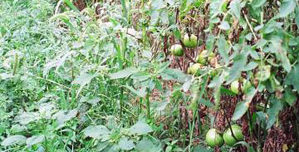Tomato Weed Management
go.ncsu.edu/readext?384553
en Español / em Português
El inglés es el idioma de control de esta página. En la medida en que haya algún conflicto entre la traducción al inglés y la traducción, el inglés prevalece.
Al hacer clic en el enlace de traducción se activa un servicio de traducción gratuito para convertir la página al español. Al igual que con cualquier traducción por Internet, la conversión no es sensible al contexto y puede que no traduzca el texto en su significado original. NC State Extension no garantiza la exactitud del texto traducido. Por favor, tenga en cuenta que algunas aplicaciones y/o servicios pueden no funcionar como se espera cuando se traducen.
Português
Inglês é o idioma de controle desta página. Na medida que haja algum conflito entre o texto original em Inglês e a tradução, o Inglês prevalece.
Ao clicar no link de tradução, um serviço gratuito de tradução será ativado para converter a página para o Português. Como em qualquer tradução pela internet, a conversão não é sensivel ao contexto e pode não ocorrer a tradução para o significado orginal. O serviço de Extensão da Carolina do Norte (NC State Extension) não garante a exatidão do texto traduzido. Por favor, observe que algumas funções ou serviços podem não funcionar como esperado após a tradução.
English
English is the controlling language of this page. To the extent there is any conflict between the English text and the translation, English controls.
Clicking on the translation link activates a free translation service to convert the page to Spanish. As with any Internet translation, the conversion is not context-sensitive and may not translate the text to its original meaning. NC State Extension does not guarantee the accuracy of the translated text. Please note that some applications and/or services may not function as expected when translated.
Collapse ▲
This tomato crop has lost its lower leaves to fungal diseases. The weeds growing adjacent to the crop row have likely prolonged leaf wetness from morning dew, thus providing a more favorable environment for fungal growth on the tomato foliage. From Mark Schonbeck, Virginia Association for Biological Farming.
This guide discusses the importance of weed management in maintaining a healthy crop. It also provides links to other weed management resources at the bottom of the page. This is part of NC State University’s guide, Southeastern US Vegetable Crop Handbook.
The Wolfpack Weeds program provides weed management resources specific to North Carolina crops. Visitors can find weed identification tools and herbicide injury examples (with photos), links to Extension publications and recommendations from experts. Wolfpack Weeds is part of the NC State Department of Horticultural Science.
This guide will aid in the identification of common weeds and weed seedlings found throughout the Southeastern US. Developed by Virginia Tech, the weed pictures in this guide are arranged alphabetically by common name and may be viewed by clicking on the letters.
Reviewed 8/16/2022
| Insects > > > |


